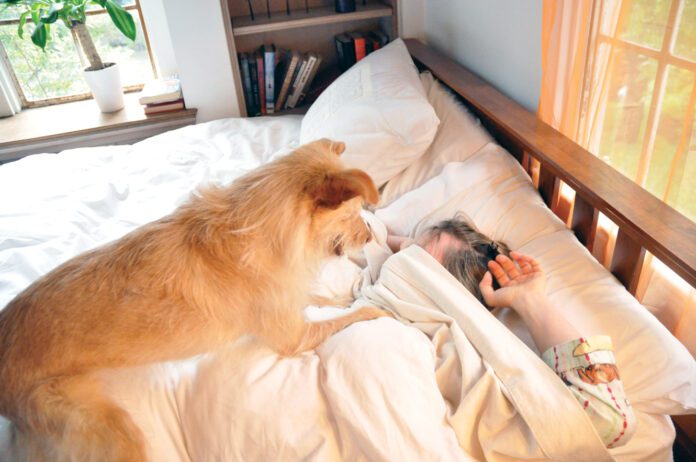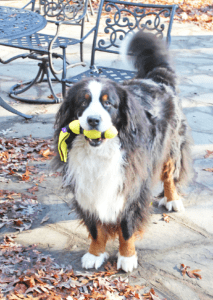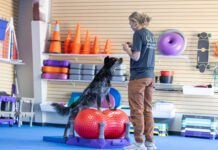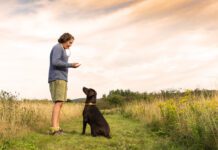
Predictability is how you calm an anxious dog. It’s your best friend when you live with a dog – particularly when you live with multiple dogs. Your enemies are The Unexpected, The Unknown, and The Unsure. The Un’s tend to make dogs jump up and run hither and yon, barking their questions, ideas, warnings, and enthusiasms. Then we humans have the job of directing the scene before us: Come! Sit! Stay! Place! Off! Leave it!
Consider this: It doesn’t have to be this chaotic, or this much work. We can significantly decrease the Un’s for our dogs by creating some precise, everyday, predictable patterns. Try it, and enjoy the newly peaceful atmosphere as both you and your dogs relax into knowing exactly what comes next.
“The Pattern Hack” Key to Calm an Anxious Dog
Kim Brophey, owner of The Dog Door Behavior Center in Asheville, North Carolina, and author of Meet Your Dog, teaches what she calls “The Pattern Hack” in her L.E.G.S. Family Dog Mediation course.
“Any animal’s brain is wired to find patterns,” she explains. “It’s a key survival skill. Patterns make the world more predictable, which saves an animal effort.” Meaning: If they can anticipate what’s next, they can allocate their precious energy appropriately.
Anybody whose dog explodes with joy when they put on those hiking shoes – or gets sad at the sight of the suitcase – has noticed that dogs are amazingly good at detecting patterns. Brophey encourages owners to take advantage of this, and identify, strengthen, and formally teach the patterns that are hiding in their daily lives to their dogs. Creating a consistent predictable pattern will help calm an anxious dog.
Visualize, then practice

The first step is to analyze the things you do every day that can sometimes get a little too crazy. Feeding the dogs? Getting ready for a walk? Welcoming a guest? Pick one scenario you wish were going more smoothly, and visualize exactly how you’d like it to play out.
The more precisely you can map out the desired scene, the better. While small differences may seem insignificant to us, they loom large for our dogs; a slight change means the situation is up for grabs. So, as you develop the pattern, remember that the more consistent you are about its details, the easier it will be for your dog to settle into it.
Once you have a clear pattern for the scenario you’d like to improve, put it into consistent daily practice. For example, here are some patterns you could establish:
WAKE-UP TIME. If your dogs nudge you to get up earlier than you’d like, teach the pattern that nobody ever gets out of bed until the alarm goes off. Whether you’ve actually set an alarm or not, always play that sound right before you get out of bed. Eventually (hopefully soon!), your dogs will stay in sleep mode until they hear that sound.
HEADING OUT THE DOOR. If your dogs jostle for position at the doorway, teach the pattern that the door never opens until all are sitting politely. It shouldn’t take long for your dogs to learn that your hand on the doorknob means that sitting will get the door open more quickly.
GUEST ENTRY. Teach that the doorbell always results in treats scattered on the dog bed, so the dogs learn to run straight to the bed at that sound, while your guests enter peacefully.
COUCH RULES. If your dogs are allowed on the couch or bed only when invited, you can make that simpler by creating a pattern around a special blanket: If the blanket is on the couch, dogs are welcome; if it’s not, dogs stay on the floor.
DOG MEALTIME. Maybe rather than jostling and whining, three dogs wait in “downs” at their specific spots as bowls are prepared, with bowls delivered in the same order each time. (Of course, if you are like my husband Tom and enjoy the chaotic anticipatory glee, you do you!)
Once you have a clear plan for a pattern or two you’d like to establish, get all the relevant humans on board with the idea that this will be the approach from now on; it will not work if the approach is haphazard! Then start teaching the dogs what you’d like to see. Precisely because these are everyday scenarios, the practice is built-in if you’re consistent. Sticking to this pattern will help calm anxious dogs and help them remain calm over the long term.
Beware of unintentional patterns
Keep in mind that patterns can work for good or for ill in your life with your dog. Sometimes we unintentionally train a troublesome pattern! That’s when it’s time to create a replacement.
Long ago with our first dogs, Tom and I would drive to a giant woodsy park for an adventure, hiking with Shadow and Kela off-lead. They’d be so good – romping, but staying within a nice little perimeter of us and always checking in – until we headed for the parking lot and the car was in sight. That’s when they’d suddenly take off for one last zoom.
We’d cool our heels for 15 minutes – calling, worrying, feeling dumb – until they’d lope back, tongues hanging out, grinning. It wasn’t until they’d done this several times that we realized that our dogs had learned this pattern: car → awesome hike → car → end-of-fun. Our solution at the time was to put the leashes on earlier and earlier, which seemed a shame.
These days, I know I should have created a new pattern: The return car has to be the Next Fun Thing. Let’s say 100% of the time there’s a bully stick or other chew toy waiting in there for the ride home. They would have learned: car → awesome hike → car → awesome-treat-that-we-only-get-in-this-scenario. The dogs would have stuck right with us, and leapt into that car.
The environment is the cue to calm an anxious dog
One of the coolest parts of the Pattern Hack is the moment you realize you don’t need to direct your pup with a string of verbal cues anymore. Instead, each scenario is its own cue: The sight of you cooking at the stove sends the dog to “settle” on his mat, and a family car pulling into the driveway sends him running for the favorite tug toy that produces a jump-free greeting. If you are consistent with how you construct and manage each situation, the environment itself cues the behavior that’s proven most rewarding for the dog.
From the behavior science point of view, Brophey says, “Patterns build and hold behavior in place far more effectively and naturally than cues ever could.” What’s more, dogs who can hang their hats on a lot of patterns often seem calmer and less anxious. These adjustments may seem small – remembering to put Spot’s bowl in front of the oven, and Rover’s by the fridge – but it all adds up to make our human world feel more predictable to our dogs. On a very deep level, they feel safer and this sense of safety is ultimately what calms an anxious dog.




